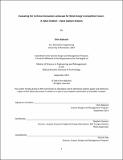| dc.contributor.advisor | Stephen Connors. | en_US |
| dc.contributor.author | Babcock, Chris (Christopher E.) | en_US |
| dc.contributor.other | Massachusetts Institute of Technology. Engineering Systems Division. | en_US |
| dc.date.accessioned | 2017-03-20T19:08:39Z | |
| dc.date.available | 2017-03-20T19:08:39Z | |
| dc.date.copyright | 2014 | en_US |
| dc.date.issued | 2014 | en_US |
| dc.identifier.uri | http://hdl.handle.net/1721.1/107501 | |
| dc.description | Thesis: S.M. in Engineering and Management, Massachusetts Institute of Technology, School of Engineering, System Design and Management Program, Engineering and Management Program, 2014. | en_US |
| dc.description | This electronic version was submitted by the student author. The certified thesis is available in the Institute Archives and Special Collections. | en_US |
| dc.description | Cataloged from student-submitted PDF version of thesis. | en_US |
| dc.description | Includes bibliographical references (pages 103-106). | en_US |
| dc.description.abstract | This thesis utilizes a systems approach to develop a framework to analyze the value creation and value capture potential of technical innovations in the wind energy sector of the electric power industry. Six technical innovations are considered for the analysis, including Grid-Scale Storage, On-Site Manufacturing Systems, Transmission Power Flow Control, Near-Term Forecasting, Long-Term Forecasting and Predictive Maintenance. Several comparative techniques are employed, including Pugh selection, weighted stakeholder occurrence based on stakeholder value networks, and a multi-attribute utility method. The technologies are compared across multiple possible future scenarios and scored based on their value contribution to stakeholders of both the wind power plant as well as the entire electric power system. Of the technical innovations analyzed in this framework, Grid-Scale Storage, On-Site Manufacturing Systems and Predictive Maintenance promise to contribute the greatest value to industry stakeholders and thus are the most likely to improve the competitiveness of the wind industry. A combined application of the multi-attribute utility method with the weighted stakeholder occurrence method based on stakeholder value networks was the most effective in distinguishing value contribution from the technologies. A value creation -- value capture matrix provides a useful method for visualizing value contribution to industry stakeholders and is used to inform commercialization strategy of the selected technologies. In addition, trade plots are utilized for selecting which technologies contribute the highest value across multiple possible future scenarios. | en_US |
| dc.description.statementofresponsibility | by Chris Babcock. | en_US |
| dc.format.extent | 131 pages | en_US |
| dc.language.iso | eng | en_US |
| dc.publisher | Massachusetts Institute of Technology | en_US |
| dc.rights | MIT theses are protected by copyright. They may be viewed, downloaded, or printed from this source but further reproduction or distribution in any format is prohibited without written permission. | en_US |
| dc.rights.uri | http://dspace.mit.edu/handle/1721.1/7582 | en_US |
| dc.subject | Engineering and Management Program. | en_US |
| dc.subject | System Design and Management Program. | en_US |
| dc.subject | Engineering Systems Division. | en_US |
| dc.title | Evaluating the technical innovation landscape for wind energy's competitive future : a value creation -- value capture analysis | en_US |
| dc.type | Thesis | en_US |
| dc.description.degree | S.M. in Engineering and Management | en_US |
| dc.contributor.department | Massachusetts Institute of Technology. Engineering and Management Program | en_US |
| dc.contributor.department | System Design and Management Program. | en_US |
| dc.identifier.oclc | 974646348 | en_US |
